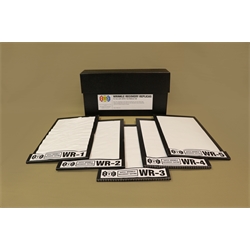Purpose of Test
This test checks the retention properties of a creased textile after being subjected to home laundering. The textile undergoes several washing and drying procedures under parameters that mirror common home laundering care.
This method evaluates the crease retention of various fabric types:
- Woven
- Nonwoven
- Knitted
Creasing techniques are not outlined since fabrics are ready to use as supplied by manufacturers. In addition, the creasing techniques depend on the fabric properties.
Terminology Defined
Crease Retention – The ability of the fabric to return from a deformed state to its original state after home laundering.
Laundering Creases – Sharp folds or lines that occur in a washed textile.
Standard Reference Detergent – A powder detergent used in top-load washing machines.
Ballast – A material used to bring the total weight of the textile to the amount specified in the test.
AATCC 3D Crease Recovery Replicas – The 3-Dimensional reference standards for evaluating the wrinkle recovery rate.

Test Method
Materials Used for Test
- Test specimens
- Automatic washing machine
- Automatic tumble dryer
- Drip dry and line dry facilities
- AATCC Standard 3D Crease Replicas
- Ballast
- Scale
- Steam or dry iron
- Floodlight with reflector
- AATCC Standard Reference Detergent

Testing Procedure
The creased test specimens follow a home laundering process and are assessed for crease retention. The appearance rating is evaluated by using the Standard 3D Crease Replicas as a guide under predetermined lighting and viewing area conditions.
Test Procedure (Summary)
- Part 1: Washing of test specimen: The laundry method is determined by following the care label instructions of the fabric. The washing machine is loaded with AATCC Standard Reference Detergent, test specimens, and a ballast. The test specimen is left to wash for a recommended setting and finish the last spin cycle.
- Part 2: Drying of test specimen: After the last spin cycle, the test specimens are transferred to the tumble dryer set at a recommended temperature based on the care label guide. When the machine stops, the test specimen is dried by line or drip at room temperature.
- Part 3: Evaluation: Wrinkles are removed, but stretching is avoided. The specimen is maintained at standard temperature and humidity conditions for 4 hours before determining the crease retention.